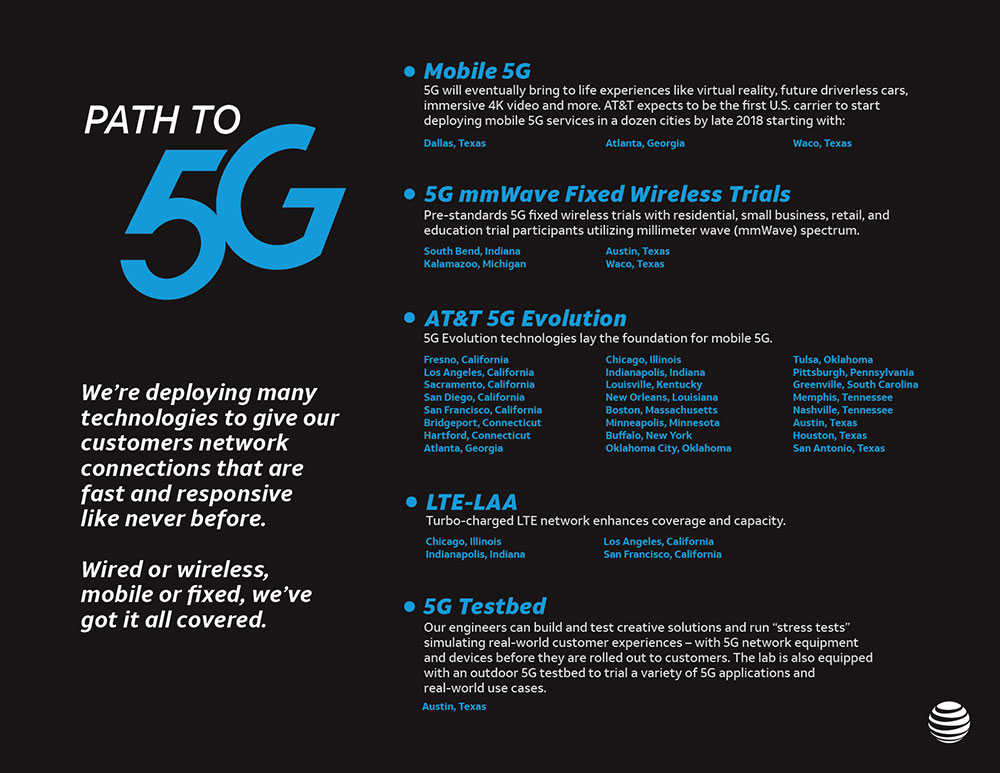
Practice makes perfect.
It's true of swinging a golf club, playing a piano, and deploying a wireless network that will fundamentally change the way we connect with the world around us. Yes, I'm talking about 5G.
It's no coincidence that AT&T is aiming to be the first U.S. carrier to launch standards-based, mobile 5G services to customers this year. We've been "practicing" for this moment for almost 2 years. And unlike some of our competitors, we plan to offer a 5G-capable device to customers this year, too. After all, what's the use of a highway without an on-ramp?
We have a history in being first when it comes to 5G. A year and a half ago, we launched the industry’s first enterprise 5G trial in Austin, Texas, to start learning about mmWave and testing 5G equipment. Shortly after we began that trial, we were hungry for more data. So we took our 5G show on the road. Late last year, we expanded 5G trials to more people and businesses in Waco, Texas, Kalamazoo, Michigan and South Bend, Indiana.
My team spent countless hours collecting data and talking to real people who elected to join the trial. What worked? What didn't? What did we need to change? Why was this happening here and not there? Would mmWave spectrum really work to deliver 5G? Did we really just hit that speed in South Bend?
We had a lot of questions when we started. And we're confident we have all the answers we need to deploy a mobile 5G network that works for people all over the country. Here are some key findings we picked up along the way.
Waco, Texas
Participants: Small and mid-sized businesses
- Provided 5G mmWave service to a retail location more than 150 meters away from the cell site and observed wireless speeds of approximately 1.2 Gbps in a 400 MHz channel.
- Observed latency rates at 9-12 milliseconds.
- Latency impacts things like the time between pressing play and seeing a video start to stream or hitting a web link and seeing a webpage begin to load. For context, MIT researchers discovered the human brain “latency” is 13 milliseconds.
- Supported hundreds of simultaneous connected users using the 5G network.
Kalamazoo, Michigan
Participants: Small businesses
- Observed no impacts on 5G mmWave signal performance due to rain, snow or other weather events.
- Learned mmWave signals can penetrate materials such as significant foliage, glass and even walls better than initially anticipated.
- Observed more than 1 Gbps speeds under line of sight conditions up to 900 feet. That's equal to the length of 3 football fields.
South Bend, Indiana
Participants: Small business and residential customers
- Observed a full end-to-end 5G network architecture, including the 5G radio system and core, demonstrating extremely low latency.
- Successfully provided gigabit wireless speeds on mmWave spectrum in both line of sight and some non-line of sight conditions.
We worked with a variety of customers in different parts of the country to conduct these trials. From a small car wash in north Austin, to the popular Magnolia Silos in Waco, to a family in South Bend. We wanted to see how 5G and mmWave worked in every type of environment-for every type of customer.
From a millennial that streams video all day on their smartphone to people who just need an internet connection to surf the web and businesses that need highly secure, reliable networks to manage their enterprise data every day.
By conducting these trials and inventing specialized measurement equipment to study other aspects of 5G in great detail, we collected mountains of data and insights to comb through, obsess over and ultimately act on. These trial learnings are guiding our commercial 5G launches this year and will help ensure we're building a 5G network that is both real and reliable for everyone.

Melissa Arnoldi is president of AT&T Technology & Operations